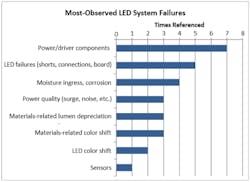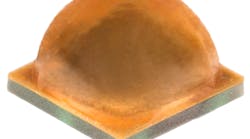The industry organization that serves to help guide the US Department of Energy SSL efforts offers an updated set of recommendations for the LED-based lighting industry and advice for lighting specifiers/buyers.
The LED Systems Reliability Consortium (LSRC), a working group within the industry-based Next Generation Lighting Industry Alliance (NGLIA), has published the third edition of the solid-state lighting (SSL) industry guide entitled "LED luminaire lifetime: Recommendations for testing and reporting." The new publication updates the group's recommendations on projecting the lifetime and reliability of solid-state lighting (SSL) products, driven primarily by the broad proliferation of packaged LEDs in new form factors and wider power ranges.
The NGLIA was formed in 2005 and has upwards of 20 members companies that are active participants in the LED-based lighting sector. The organization serves to help guide the US Department of Energy SSL program and to jointly advance the deployment of LED-based lighting products and deliver reduction in energy usage attributable to lighting.
In the new report, the authors — from leading industry organizations, consulting firms, and the DOE — state that the number and variety of packaged LED types led the need for an updated guide. Indeed, LEDs now span the range from fractions of a watt to 50W and come in low-cost plastic packages to chip-on-board (COB) packages based on ceramic to metal substrates. Moreover, the industry has developed some additional testing and reliability standards that come into play today.
The report notes that the task of documenting and projecting SSL product life is especially challenging. The industry has developed standards for documenting and projecting LED performance in LM-80 and TM-21. There are standards such as LM-79, LM-84, and TM-28 that have further improved the reporting on lamp and luminaire designs.
Still, SSL products are very complex with failure modes beyond the light source. The nearby chart shows failure causes documented by the LSRC. The report also notes that the industry still lacks comprehensive color-maintenance testing and the ability to robustly use accelerated life testing.
The current state of the LED industry led the authors to offers some of the following new or updated recommendations:
- Color shift should now be considered alongside light output in defining product lifetime. Previously the document excluded color shift as a factor in end-of-life determination.
- The authors recommend that the industry classify products as replacement lamps, standard-grade luminaires, and specification-grade luminaires with designated levels of color stability.
- The group dropped the prior recommendation for a statistical system methodology to project reliability, noting that the effort is not realistic in light of the variety of designs and applications.
- Likewise, the group decided that there is no consensus method for defining standard luminaire lifetime and that the recommendation of adding such a metric to the DOE Lighting Facts program is not realistic.
The full report is on the NGLIA website. Likewise, the DOE has posted the report on its website. The detailed document has some excellent inforomation about overstress testing of LEDs to further reliability learning and about the overall makeup of MTBF (mean time between failure) specs for SSL products. We also have an excellent feature coming in our October issue, due on the website in a matter of days, that covers overstress testing and MTBF in automotive applications. Watch for it!







